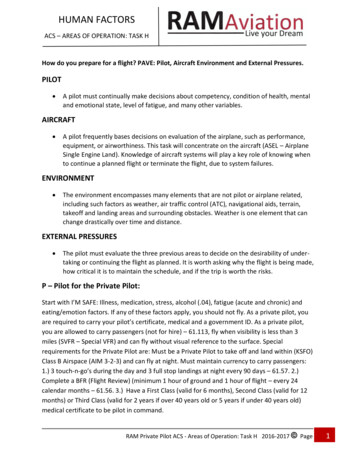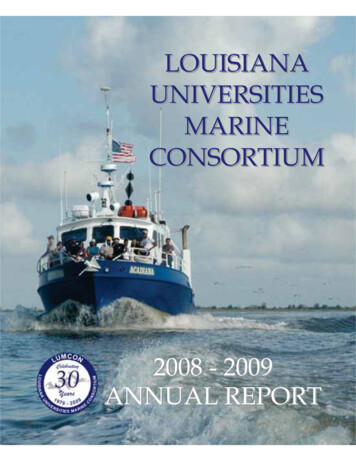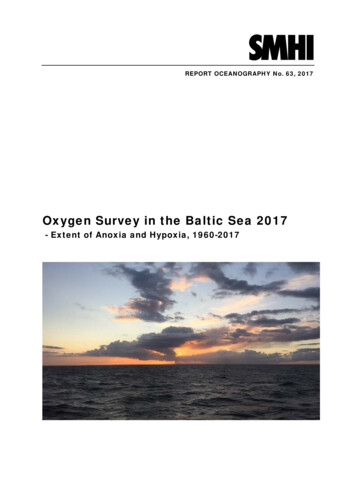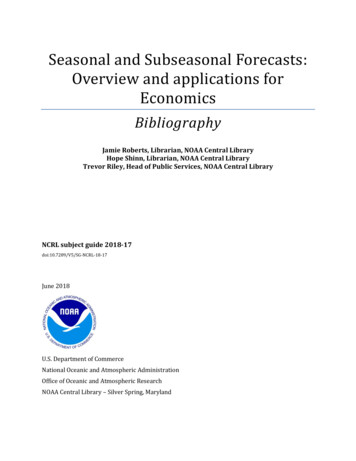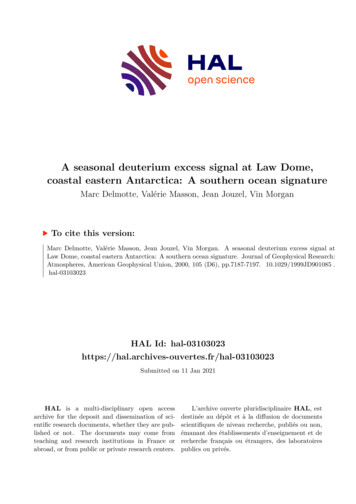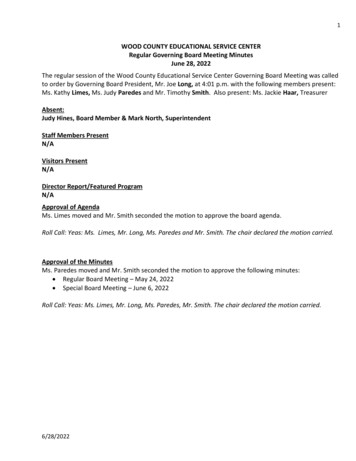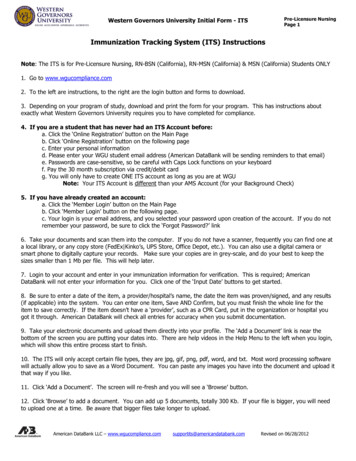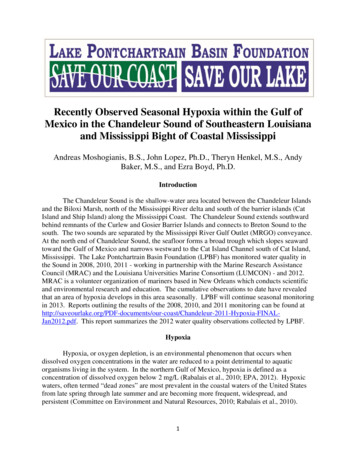
Transcription
Recently Observed Seasonal Hypoxia within the Gulf ofMexico in the Chandeleur Sound of Southeastern Louisianaand Mississippi Bight of Coastal MississippiAndreas Moshogianis, B.S., John Lopez, Ph.D., Theryn Henkel, M.S., AndyBaker, M.S., and Ezra Boyd, Ph.D.IntroductionThe Chandeleur Sound is the shallow-water area located between the Chandeleur Islandsand the Biloxi Marsh, north of the Mississippi River delta and south of the barrier islands (CatIsland and Ship Island) along the Mississippi Coast. The Chandeleur Sound extends southwardbehind remnants of the Curlew and Gosier Barrier Islands and connects to Breton Sound to thesouth. The two sounds are separated by the Mississippi River Gulf Outlet (MRGO) conveyance.At the north end of Chandeleur Sound, the seafloor forms a broad trough which slopes seawardtoward the Gulf of Mexico and narrows westward to the Cat Island Channel south of Cat Island,Mississippi. The Lake Pontchartrain Basin Foundation (LPBF) has monitored water quality inthe Sound in 2008, 2010, 2011 - working in partnership with the Marine Research AssistanceCouncil (MRAC) and the Louisiana Universities Marine Consortium (LUMCON) - and 2012.MRAC is a volunteer organization of mariners based in New Orleans which conducts scientificand environmental research and education. The cumulative observations to date have revealedthat an area of hypoxia develops in this area seasonally. LPBF will continue seasonal monitoringin 2013. Reports outlining the results of the 2008, 2010, and 2011 monitoring can be found handeleur-2011-Hypoxia-FINALJan2012.pdf. This report summarizes the 2012 water quality observations collected by LPBF.HypoxiaHypoxia, or oxygen depletion, is an environmental phenomenon that occurs whendissolved oxygen concentrations in the water are reduced to a point detrimental to aquaticorganisms living in the system. In the northern Gulf of Mexico, hypoxia is defined as aconcentration of dissolved oxygen below 2 mg/L (Rabalais et al., 2010; EPA, 2012). Hypoxicwaters, often termed “dead zones” are most prevalent in the coastal waters of the United Statesfrom late spring through late summer and are becoming more frequent, widespread, andpersistent (Committee on Environment and Natural Resources, 2010; Rabalais et al., 2010).1
The formation of hypoxia (Figure 1) may be a result of a number of factors, from bothnatural and anthropogenic sources, but are mainly driven by excess nutrients to a system(eutrophication – see below), and stratification of the water column due to salinity andtemperature gradients (EPA, 2012; LUMCON, 2012). Freshwater discharge from riversintroduces nutrient-rich water into an ecosystem. Phytoplankton, or algae, feed on thesenutrients and sink because of their increased size and biomass (Bricker et al., 1999). Throughoutthe water column, zooplankton eat algae. As the phytoplankton are consumed, zooplanktonexcrete fecal pellets which sink to the seafloor where bacteria decompose the nutrient-rich fecalpellets and algae. This process known as bacterial respiration, consumes most of the life-givingoxygen supply in the bottom waters, resulting in organism stress and mortality (Howarth et al.,2011). In the Gulf of Mexico, the increased turbidity from the Mississippi River discharge limitsphytoplankton production in bottom waters because light does not penetrate this region of thewater column, therefore phytoplankton cannot produce oxygen through photosynthesis in thebottom waters (Bricker et al., 1999; Anderson et al., 2002; Howarth et al., 2011).Figure 1. Schematic showing how hypoxia can develop at depth in the water column.Source: /hypoxia101.cfmIn addition to eutrophication, stratification of the water column is essential in thedevelopment of hypoxia. Freshwater discharge contains fresh (zero salinity) water which is lessdense than the saline and cold bottom water of the ocean. As river discharge brings warmer,fresh water to a coastal environment, the freshwater floats on top of the more dense (higher2
salinity, lower temperature) oceanic water. This process causes a pycnocline to develop, or layerwhere the density gradient is greatest, which prevents vertical mixing of oxygen-rich surfacewater with oxygen-depleted bottom water of the Gulf (EPA, 2012).As a result of seasonal stratification of the water column in the absence of strong windsor currents, oxygen consumption rates in the bottom water easily exceeds the rate of resupply ofoxygen from both primary production, and diffusion of oxygen from the atmosphere into thelower reaches of the water column, resulting in hypoxia, or low dissolved oxygen concentrations(Howarth et al., 2011). During the fall and winter, a strong storm like a hurricane or cold front,can induce strong mixing which is the most rapid and efficient mechanism to deliver oxygen tothe bottom (LUMCON, 2012).EutrophicationEutrophication is an increase in the rate of supply of organic matter and chemicalnutrients (primarily nitrogen and phosphorus) to an ecosystem to an extent that increases theprimary productivity of the ecosystem. Although eutrophication is a natural process, in recentyears eutrophication has been accelerated by human or anthropogenic activities where the releaseof sewage effluence and agricultural run-off carrying fertilizers is introduced to an aquaticsystem (Jorgensen and Richardson, 1996; Bricker et al., 1999).3
Summary of 2008, 2010, and 2011 ResultsIn 2008, two marine surveys fortuitously documented the occurrence of a low oxygenlayer in Chandeleur Sound. In June 2008, the University of Southern Mississippi wasconducting shark research and collected environmental data and water quality data in theChandeleur Sound. Later that month, the Nekton Research Laboratory at the University of NewOrleans was en route to do research around the Chandeleur Islands and collected water qualitydata while crossing the Chandeleur Sound. These two data sets were provided to LPBF and areshown on Figure 2.Figure 2. Map of the Chandeleur Sound area and the approximate location of low dissolvedoxygen observed in 2008 by University of New Orleans and the University of SouthernMississippi.In July 2010, LPBF, in partnership with MRAC, developed a water quality monitoringprotocol for the Chandeleur Sound which was surveyed to ascertain if the low dissolved oxygendetected in 2008 was an anomaly for that year or if it was a reoccurring phenomenon. Briefly,Two transects were selected which crossed the deepest axial through portions of the ChandeleurSound. One transect ran through the Cat Island Channel to the deep hole near the northern endof Chandeleur Sound. The other transect ran from eastern Ship Island southward to the centralarea of the Chandeleur Sound. A YSI Pro-2030 meter with a 90 foot cable was used to measuresalinity, temperature, and dissolved oxygen concentrations. The YSI cable was marked at twofoot intervals. First, the total depth was determined using two on-board acoustic depth finders.Next, the probe on the instrument was lowered to take measurements at three depths; two feet4
beneath the surface, at mid-depth, and one foot from the seafloor. Hypoxia was detected again inthe Chandeleur Sound area (Figure 3).Figure 3. Map of Chandeleur Sound with the area of hypoxia observed in August 2010.In July 2011, a joint effort between LPBF and MRAC measured and collected waterquality data and observations using the same transects (Figure 4, circles), sampling protocol,and sampling frequency plan developed in 2010. A total of 15 stations were acquired in July2011. Additional data was collected by LUMCON which monitored water quality off the coastof Mississippi during the same time period in July 2011. LUMCON surveyed an area in the Gulfof Mexico starting 8 miles from the coast of Mississippi to 24 miles into the Gulf (Figure 4,triangles). The survey was conducted in deeper waters on the continental shelf to measurehypoxia and other water quality parameters. The specific data collected by LUMCON is notincluded in this report but the extent of hypoxia that was detected by LUMCON has beencombined with the hypoxia detected by LPBF-MRAC to gain a total picture of the area ofhypoxia off of the coast of Southeast Louisiana and coastal Mississippi.5
Figure 4. Map of LPBF-MRAC and LUMCON sampling locations in the ChandeleurSound, Mississippi Bight, and the Gulf of Mexico.As a result of the July 2011 water quality sampling, a large area of bottom water hypoxiawas detected in the vicinity of the Chandeleur Islands extending into the Gulf of Mexico(Figure 5). The area of the detected hypoxia was approximately 1,050 square miles. However,the hypoxic zone was most likely larger as data collection did not extend past theMississippi/Alabama border. A total of 43 points were surveyed between the LPBF-MRAC andLUMCON sampling efforts (Figure 4). Of these 43 points, hypoxia was measured in the bottomwater as 25 sites, over half of the points surveyed.6
Figure 5. Map showing the area of hypoxia detected in LPBF-MRAC and LUMCON surveys inJuly of 2011. The area of hypoxia most likely extends further east but the survey was terminatedat the Mississippi/Alabama boarder.7
2012 MethodsIn July 2012, LPBF measured and collected water quality data and observations using thesame transects (Figure 4, circles), sampling protocol, and sampling frequency plan developed in2010. The two transects named NW## (yellow pushpins) and NE## (green pushpins) weresampled, as well as, five new alternative stations (ALT##; red pushpins) were also sampled tobetter capture the extent of hypoxia west of the Chandeleur Islands (Figure 6).Figure 6. Map of locations of July 2012 LPBF sampling stations.ResultsA hypoxic zone at depth was detected in July 2012 in the Chandeleur Sound andMississippi Bight, at the intersection of the NW and NE transects (Figure 7). The area detectedwas approximately 70 square miles. The hypoxic zone was most likely larger, similar to resultsfrom previous years, however, data collection for 2012 did not extend past the Chandeleur Soundand the Ship Island/Horn Island Pass. A total of 18 locations were sampled by LPBF, of which8
five of these stations demonstrated oxygen concentrations considered to be hypoxic, less than 2mg/L.Figure 7. Map showing the sampling stations for LPBF surveys in July of 2012 and hypoxicarea. Low oxygen concentrations were measured at five stations and the red area indicates theestimated extent of hypoxia as a result of the sampling. The eastern extent of hypoxia isunknown.Figures 8, 9, and 10 illustrate the depth-dependent segregation of dissolved oxygen,salinity, and temperature data, which demonstrates the development of a pronounced boundarybetween lower salinity, oxygen-rich waters above, and higher salinity, oxygen-depleted watersbelow.9
Dissolved Oxygen vs. DepthDissolved Oxygen (mg/L)Depth (feet)012345678905101520253035404550Figure 8. Graph showing dissolved oxygen with depth in 2012, using LPBF data. Notice adecline of dissolved oxygen with depth.Salinity vs. DepthSalinity (ppt)10 11 12 13 14 15 16 17 18 19 20 21 22 23 24 25 26 27 28 29 30 31 320510Depth (feet)1520253035404550Figure 9. Graph showing changes in salinity with depth in 2012, using LPBF data. Notice theincrease in salinity with depth. The anomaly, or outlier, at 11 ppt and 18 feet deep was measuredthree separate times with two different instruments, therefore confirming the accuracy of thispoint. This measurement was taken one foot from the seafloor at station NW-02.10
Temperature vs. DepthTemperature (⁰C)Depth (feet)272829303105101520253035404550Figure 10. Graph showing change in water temperature with depth in 2012, using LPBF data.Notice the cooler temperatures with depth, as expected.In the hypoxic zone, the lower layer had an average of 4.5 mg/L lower oxygenconcentration, 3.7 ppt increase in salinity, and 2.3 C decrease in temperature (Table 1). In thearea where hypoxia was not present, the differences between the upper layer and lower layer indissolved oxygen, salinity, and temperature were negligible as the water column was fairly-wellmixed between the upper and lower layers (Table 2).Table 1. Average difference in dissolved oxygen, salinity, and temperature between the upperand lower layers of the water column in 2012 in the hypoxic zone.Upper layerLower layerDifferenceHypoxic Area (5 out of 18 stations)Average SalinityAverage D.O. (mg/l) (ppt)5.8926.21.3829.9-4.513.7Average Temperature ( C)30.227.9-2.3Table 2. Average difference in dissolved oxygen, salinity, and temperature between the upperand lower layers of the water column in 2012 in the area of no hypoxia.Upper layerLower layerDifferenceNon-hypoxic Area (13 out of 18 stations)Average D.O. (mg/l) Average Salinity (ppt)6.1724.94.8524.8-1.32-0.111Average Temperature ( C)29.929.1-0.8
In July 2012, hypoxia developed in waters deeper than 24 feet. The hypoxia continuedinto deep water but always developed near the bottom with the hypoxia boundary (pycnocline)growing deeper with increasing water depth. Figures 11 and 12 show the depth profile and thedepth of the pycnocline for data collected by LPBF along the two transects, NW and NE, shownin Figure 6 as yellow and green, respectively.Figure 11. Depth profile created from data taken along the transect running from the northwestnear Cat Island to the southeast crossing just north of the Chandeleur Islands.12
Figure 12. Depth profile created from data taken along the transect running from the southwestin the Chandeleur Sound to the northeast near Ship Island.DiscussionIn 2008, the hypoxia detected was detected in June. In 2010, the early stages of hypoxiawere detected in May, which became more prevalent in July, and was even more extensive inAugust. By October, strong mixing of the Gulf caused oxygen concentrations in bottom watersto increase, therefore terminating the existence of the hypoxic water mass. The development ofhypoxia is most likely seasonal and occurs in the summer months when coastal waters becomeheated. The stratification, and therefore hypoxia, is most likely disrupted by cold fronts, strongstorms and hurricanes that are prominent in the area during late summer and early fall. The fullextent of the effect of these hypoxic events on the organisms and ecology of the region isunknown. The impacts on fish are most likely small as they can move into more oxygenatedwaters. Less mobile organisms like shrimp, crabs, and other crustaceans, that live near thebottom may become stressed and eventually suffocate under hypoxic conditions in the bottomwater, depending on the length of exposure to the oxygen-poor environment.The well-documented dead zone along the Louisiana coast in the Gulf of Mexico isthought to be triggered by excess nutrients and stratification of the water column which is aseasonal phenomenon occurring in the summer months (Rabalais et al., 2002). Prior to theclosure of the Mississippi River Gulf Outlet (MRGO), the well-documented dead zone in LakePontchartrain was triggered by high salinity water which had been allowed to enter LakePontchartrain via the MRGO and the Industrial Canal (Poirrier, 1978; Poirrier et al., 1984; LPBF2006). In both the Gulf and Lake dead zones, a lack of circulation and cumulative demand onoxygen within the water column, have conspired to create very low oxygen concentrations inbottom waters. Many sessile organisms that inhabit the bottom are very likely to suffocate and13
die, even with minor exposure to the low oxygen environments. Hence these are referred to as“dead zones”. In Lake Pontchartrain, the dead zone was evident by the absence of large lakeclams (Rangia cuneata), simply because clams were killed before they could mature (Poirrier etal., 1984).At this time it is still speculative to draw conclusions, but a few relevant observations canbe made. In 2008, there was unusually high water on the Mississippi River, and the BonnetCarré Spillway was opened which discharged nutrient-rich river water into Lake Pontchartrainwhich eventually made its way through Lake Borgne, and eventually into the Chandeleur Sound.This occurred prior to the low oxygen observations in June. In addition, algal blooms did occurin Lake Pontchartrain in 2008 (Mofatt and Nichol, 2010). The spillway opening undoubtedlyadded freshwater and nutrients (stratification and eutrophication) to Chandeleur Sound, and mayhave contributed to the low oxygen event in 2008. In 2010, the Bonnet Carré Spillway was notopened, however, the Mississippi River had an extended period of high water. Also in 2010, dueto the British Petroleum (BP) oil spill response resulting from the Deepwater Horizon blowout,freshwater diversions such as Caernarvon were opened to their maximum operable capacity foran extended period of time to create a freshwater plume to prevent oil from coming into thecoastal waters of Louisiana and Mississippi. The additional nutrient rich, fresh river water in2010 may have contributed to the low oxygen concentrations observed during this time period.The hypoxia appears to have developed between May and July in 2010, and in early August,there were unofficial reports of “red tide” in the Chandeleur Sound indicating the possibility ofexcess nutrients, enough to maintain hypoxic water masses in the bottom waters (TimesPicayune, 2010).In 2011, the Bonnet Carré Spillway was again opened at full capacity for 42 days in Mayand June. No significant algal blooms occurred in Lake Pontchartrain in 2011, possibly due to alower ratio of phosphorus and nitrogen in the river water (Nguyen et al., 2011; Roy et al., 2011).However, there are some rivers that flow into the Gulf of Mexico off of the Mississippi coast,such as the Pearl River, Mobile River, and Pascagoula River, which may have introduced highconcentrations of nutrients to coastal waters. These excess nutrients could have also entered theChandeleur Sound and contributed to the formation of deepwater hypoxia in this area in 2011.However, it is unrealistic that the high nutrient concentrations remained high enough to causehypoxia extending all the way to the Mississippi/Alabama border. In addition, the high salinityof the upper layer suggests that the freshwater influence was minimal. Therefore, it isquestionable whether high nutrient concentrations are the primary cause of hypoxia, and perhapsother hypotheses should be considered.It appears that the cause of the formation of hypoxia may be a naturally inducedphenomenon simply due to the lack of wind and wave energy available to mix the coastal waterswith deep Gulf of Mexico water, therefore causing density driven stratification to develop on aseasonal basis (Table 1).14
The hypoxic area is a reentrant that appears to be isolated from ocean currents prevalentin the open Gulf of Mexico. Figure 13 indicates that the region where hypoxia develops isbypassed by the prevailing currents in the Gulf of Mexico. The hypoxia also sets up at a time ofthe year when winds are low in the summer. The combination of low winds and a lack ofhorizontal surface currents (Figure 14), creates a low energy environment which allows forstratification of the water column to develop. Figures 13 and 14 show both, that low speedcurrents are present in the summer, or in this case when hypoxia was observed in July 2012, andhow the hypoxic area east of the river is out of the main path of prevailing Gulf of Mexicocurrents. Low wind velocity is in direct correlation with lack of vertical mixing and thereforestratification and hypoxia develops (McCardell and O’Donnell, 2006).Figure 13. Location of seasonal hypoxia observed east of the Mississippi River, in a regionalcontext, showing how the hypoxic area is out of the path of the prevailing Gulf of Mexicocurrents.15
ObservedHypoxiaFigure 14. Horizontal surface currents in the Gulf of Mexico on July 16, 2012. Notice the lowspeed currents that are present and how the hypoxic area east of the river is out of the maincurrent. (Image source: NOAA: EMC Modeling and Analysis ?-gulfmex-cur-0-small-rundate 20120716).The low oxygen layer in the Chandeleur Sound is much smaller than the typical annualdead zone in the Gulf of Mexico, however, its re-occurrence over a significant portion of theChandeleur Sound may be of ecological significance. In several years of this study, (2008, 2010,and 2011), there has been potential sources of excess nutrients entering the system. The excessnutrients and seasonal stratification may be the contributing factors to the development ofhypoxia in a manner similar to the development of the “dead zone” off of the Louisiana-Texasshelf (Rabalais et al., 2002). Although the cause of the development of hypoxia in theChandeleur Sound and coastal Mississippi may be natural, anthropogenic, or a combination ofboth, the exact permutation of factors that leads to the development of hypoxia still remainsunknown.Due to conditions present in the hypoxic zone in the summer time (low winds, outside ofprevailing current path, warm shallow waters) it is probable that the observed stratificationdevelops on a consistent basis due to existing natural conditions, regardless of anthropogenicnutrient inputs. The question remaining seems to be whether excess nutrients are necessary toincrease the biological oxygen demand (BOD) and deplete oxygen in the stratified water over theshort seasonal time period that it develops. It is intriguing that the exact opposite energycondition prevails within a tropical system. Tropical systems, or hurricanes/tropical depressions,16
have strong east or southeast winds which tend to focus water through the reentrant (hypoxic)area. These events undoubtedly cause significant mixing and likely terminate seasonal hypoxia.An example of this effect was Tropical Storm Lee, in early September, which most likely endedthe bottom water hypoxia event in 2011.In 2012, hypoxia was detected in the bottom waters at 5 of the 18 stations sampled. Theeastern extent of the hypoxic area is still unknown as sampling efforts did not take place past eastof the Ship Island/Horn Island Pass, however, because of the low winds in the summer months,warm shallow waters, and the fact that this region is outside of the prevailing current path(Figure 14), it is more than likely that the hypoxic area east of the Mississippi River extendedpast the Ship Island/Horn Island Pass, further into the Mississippi Bight, similar to theobservations in 2011. However, based on LPBF observations, the hypoxic zone observed in theChandeleur Sound in 2012 was smaller than the zone observed in 2011. A similar studyconducted by Nancy Rabalais at LUMCON discovered the same results on the Louisiana-Texasshelf, stating that the “dead zone” that develops every spring and summer in the Gulf of Mexicois smaller than usual this year. It is suggested that the dead zone west of the river is small thisyear as a result of less eutrophication from rivers. The record drought across the country meantfewer nutrients were washed into the river which would have limited the amount of nutrients intothe coastal areas of Chandeleur Sound and the Mississippi Bight, and furthermore the Gulf ofMexico (NOAA, 2012).Another factor that could have inhibited the growth and development of hypoxia in theChandeleur Sound and Mississippi Bight in 2012 was Tropical Storm Debby which formed inthe northern Gulf of Mexico on June 23rd. Debby remained in the Gulf for several days untilmaking landfall on the eastern Florida panhandle on June 26th. Tropical storms (in addition tohurricanes and cold fronts) can disrupt stratification throughout the water column whichtemporarily replenishes the bottom waters with oxygen and reduces hypoxic conditions(Ariyama and Secor, 2010; LUMCON, 2012). As a result of the drought throughout theMississippi River watershed and disruption of the water column as a result of Tropical StormDebby, the dead zone in 2012 was smaller than expected.It is important to move forward from speculation of the development of hypoxia anddiscover the actual cause of this phenomenon. To ascertain the cause of the hypoxia in theChandeleur Sound and Mississippi Bight, LPBF will continue seasonal monitoring in 2013 tocharacterize the water quality and better understand the nature of the low oxygen event whichmay provide a basis for recommendations to reduce the occurrence or environmental impact ofthe Chandeleur Sound dead zone. The goal is to expand the research program to includemultiple samplings throughout the year, and through the duration of the hypoxic event todetermine when hypoxia develops and when it disappears, and the changes throughout theseason. LPBF will investigate the predicted local and regional currents to determine if thehypoxic area is indeed outside of the prevailing current path and therefore stratification developsreadily. LPBF will collaborate with other agencies to ascertain the full extent of the hypoxicarea off of the Mississippi and Alabama coast. This will be a larger collaborative sampling effortas samples will need to be collected around the same time following similar protocols so the datacan be combined and compared. Additionally, studies into the effects of hypoxic events on themarine ecology will also need to be included. Finally, the Chandeleur hypoxic zone will becompared to other hypoxic events, such as the one along the Louisiana-Texas shelf, west of the17
Mississippi River, in addition to other global hypoxic events like the Chesapeake Bay and LongIsland Sound, to better understand the drivers and causes of this phenomenon locally.18
ReferencesAnderson, D.M., P.M. Gilbert, and J.M. Burkholder. 2002. Harmful algal blooms andeutrophication: Nutrient sources, composition, and consequences. Estuaries 25(4b): 704726.Ariyama, H. and D.H. Secor. 2010. Effect of environmental factors, especially hypoxia andtyphoons, on recruitment of the gazami crab Portunus trituberculatus in Osaka, Japan.Fisheries Science 76: 315-324.Bricker, S.B., C.G. Clement, D.E. Pirhalla, S.P. Orlando, and D.R.G. Farrow. 1999. NationalEstuarine Eutrophication Assessment: Effects of Nutrient Enrichment in the Nation’sEstuaries. NOAA, National Ocean Service, Special Projects Office and the NationalCenters for Coastal Ocean Science. Silver Spring, MD: 71 pp.CENR. (Committee on Environment and Natural Resources). 2010. Scientific assessment ofhypoxia in U.S. coastal waters. Interagency Working Group on Harmful Algal Blooms,Hypoxia, and Human Health of the Joint Subcommittee on Ocean Science andTechnology. Washington, DC. September 2010.EPA. (Environmental Protection Agency). 2012. Hypoxia 101. Mississippi River Gulf of MexicoWatershed Nutrient Task Force. United States Environmental Protection Agency, Officeof Wetlands, Oceans, and Watersheds. August 2012. Available sin/hypoxia101.cfmHowarth, R., F. Chan, D.J. Conley, J. Garnier, S.C. Doney, R. Marino, and G. Billen. 2011.Coupled biogeochemical cycles: eutrophication and hypoxia in temperate estuaries andcoastal marine ecosystems. Front. Ecol. Environ. 9(1): 18-26.Jorgensen, B.B. and K. Richardson. 1996. Eutrophication: definition, history, and effects. In:Coastal and estuarine studies: Eutrophication in coastal marine ecosystems, pp. 1-20.American Geophysical Union, Washington, DC.LPBF (Lake Pontchartrain Basin Foundation). 2006. Comprehensive Habitat Management Plan,SaveOurLake.org.LUMCON (Louisiana Universities Marine Consortium). 2012. Hypoxia in the Northern Gulf ofMexico. August 2012. Available at: www.gulfhypoxia.net.McCardell, G. and J. O’Donnell. 2006. Vertical mixing rates and hypoxia in Western LongIsland Sound. Long Island Sound Research Conference Proceedings 2006.Moffatt and Nichol. 2010. Review and analysis of Pontchartrain estuary water quality asimpacted by opening of the Bonnet Carré Spillway. Submitted to: U.S. Army EngineerDistrict, New Orleans, Louisiana. (PI: Dr. Mark Dortch).19
Nguyen, N.T., E.D. Roy, S.J. Bentley, and J.R. White. Effects on the 2011 Bonnet CarréSpillway opening on Lake Pontchartrain sediment phosphorus loading and concentrationswith potential for release to the water column. Basics of the Basin Research ConferenceProceedings. SaveOurLake.org.NOAA. (National Oceanic and Atmospheric Administration). 2012. NOAA Scientists: Midwestdrought brings fourth smallest Gulf of Mexico ‘dead zone’ since 1985. National Oceanand Atmospheric Administration, United States Department of Commerce. July 27,2012. Available 27 midwestdrought.htmlPoirrier, M.A. 1978. Studies of salinity stratification in southern Lake Pontchartrain near theInner Harbor Navigation Canal. The proceedings of the Louisiana National Academy ofSciences. Vol. XLI, pp. 26-35.Poirrier, M.A., T.M. Soniat, Y. King, and L. Smith. 1984. An evaluation of the southern LakePontchartrain benthos community. Final Report to the Louisiana Department ofEnviromental Quality:79.Rabalais, N.N., R.E. Turner, and D. Scavia. 2002. Beyond science into policy: Gulf of Mexicohypoxia and the Mississippi River. (Articles). BioScience. Feb 2002; 52, 2; ResearchLibrary pg. 129.Rabalais, N.N., R.J. Diaz, L.A. Levin, R.E. Turner, D. Gilbert, and J. Zhang. 2010. Dynamicsand distribution of natural and human-caused hypoxia. Biogeosciences 7:585-619.Roy, E.D., J.R. White, S. Bargu, S.J. Bentley, C.Y. Li, and N. Walker. 2011. Nutrientdynamics in Lake Pontchartrain during and after the 2011 Bonnet Carré Spillwayopening. Basics of the Basin Research Conference Proceedings. SaveOurLake.org.Times-Picayune. 2010. Algae choking Breton, Chandeleur Sounds. Published in: TimesPicayune. Wednesday, August 11, 2010, New Orleans, LA. Available at:http://www.nola.com/ne
and Mississippi Bight of Coastal Mississippi Andreas Moshogianis, B.S., John Lopez, Ph.D., Theryn Henkel, M.S., Andy Baker, M.S., and Ezra Boyd, Ph.D. Introduction The Chandeleur Sound is the shallow-water area located between the Chandeleur Islands and the Biloxi Marsh, north of the Mississippi River delta and south of the barrier islands (Cat
